Small Was Beautiful, Once: Stylish Coupes from the Radwood Era
The small coupe is today effectively extinct. But for a glorious decade or so, just as the 1980s drew to a close and then bleeding for a few years into the 2000s, any number of manufacturers would have happily sold you a compact 2+2, roughly 13 feet long and fizzing from a small engine up front.
Some hid their low-budget roots better than others, but all were more stylish than the cars whose base they sat upon. Few were as practical as their hatchback siblings, but T-tops, pop-ups, glassy cabins, and low-set driving positions all made up for that, while slippery shapes and lightweight bodies helped extract slow-car-fast entertainment from occasionally underpowered mechanicals.
Today they remain low-cost fun, while their rarity and distinctive aesthetics make each and every one a guaranteed Radwood star. Below we’ve concentrated on the smallest, most affordable end of the spectrum; we’ll leave the Celicas, Preludes, and Probes for another time.
Ford Escort ZX2

What is it? The even curvier two-door version of the already-curvy 1990s Escort. Effectively a Mazda underneath, with similarities to cars like the Protegé and MX-3, but a 130-hp Zetec four-cylinder under the hood. It debuted in 1998 and carried on into the 2000s, hanging onto the coat-tails of increasingly popular Japanese sport compacts, which of course it kinda was itself.
Why was it great? In period, quirky styling plus a reasonable dose of power for not much money was the long and short of it. Handling was tidy, too. Today, 1990s nostalgia plays a big part in its appeal, though like many cheaper cars of the era, the disposability factor and its status as a popular tuner car in the early 2000s mean it’s not easy to find nice ones now.
Geo Storm
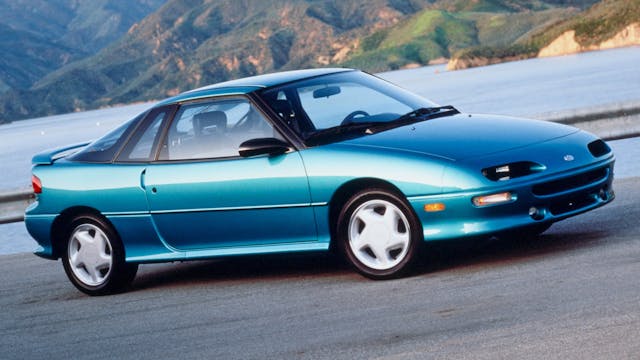
What is it? Less of a disaster than the 2017 movie of nearly the same. In fact, it’s probably one of the decade’s best-looking small coupes, a rebadge of Japan’s Isuzu Gemini coupe and powered by a lineup of single- and twin-cam fours. The glassy “Wagonback” variant is more of a shooting brake than a coupe but catnip to those of a Radwood persuasion.
Why was it great? The styling’s probably better appreciated now than at launch, but the high-revving GSi was a bit of a stormer for the era, with Car and Driver launching one to 60 mph in a lick over 7 seconds. It gripped hard too, helped by weighing little more than a ton. Basically, any imperfections it might have had when new can now be overlooked for its low-set driving position and buzzy stick-shift thrills.
Honda CRX
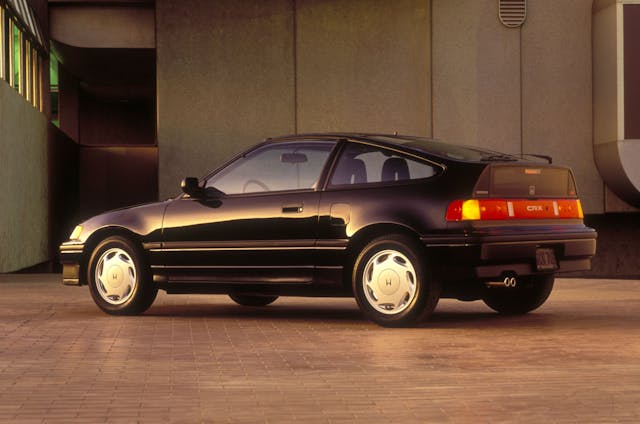
What is it? A fourth-generation Civic with a shorter wheelbase, shorter body, and a lower, raked roofline. The second-gen CRX is really a child of the 1980s, but its cultural impact extended well into the ‘90s and 2000s and outweighed its Del Sol successor, so we’re including it here. A wide range of engines across various markets meant the CRX served the purpose of everything from a good-looking commuter to a true front-drive sports car.
Why was it great? The styling, and the spiciest engines. The CRX really came of age in its second generation, somehow both cheeky and sophisticated, and gave Honda the design cue of a split rear window, which it has used on umpteen cars since, including the CRX’s spiritual successors—the Insight and CR-Z. But the availability in some markets of a 158-hp 1.6-liter VTEC engine and four-wheel double-wishbone suspension made it screaming good fun, too.
Hyundai Scoupe

What is it? An early attempt by Hyundai at drumming up excitement in its otherwise very worthy, price-first model lineup. The Scoupe lasted from 1990 until 1995, with naturally aspirated and turbocharged versions and a play-it-safe three-box silhouette, before making way for the more novel Tiburon.
Why was it great? Less “great” than maybe just “kind-of alright.” Best appreciated in turbo form, but that still only got you 114 hp—and even that was a bit too much for the chassis to handle. Better viewed today as a rare, unusual relic from the era than as one of the decade’s better small coupes. Provided you can find one, anyway.
Isuzu Impulse RS
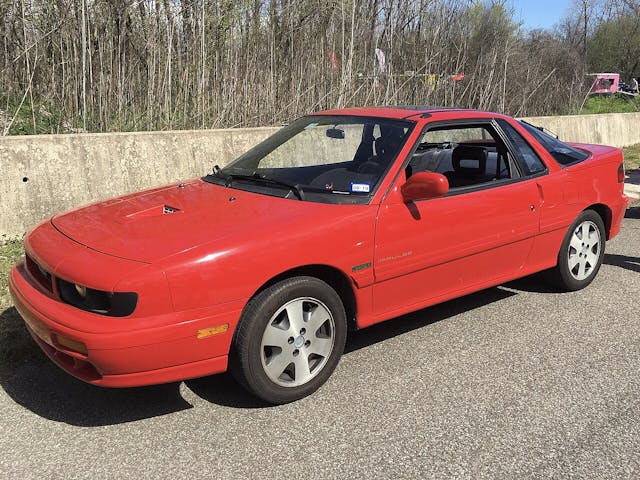
What is it? A cousin of the Geo Storm above, and a successor to the rear-drive, “Handling by Lotus,” Giugiaro-designed Piazza. The Impulse was front- or all-wheel drive and wasn’t penned by Italian talent, though it was tweaked in a Norfolk shed and it did have input from a man called Shiro Nakamura, who today is better known for leading the team that created cars like the R35 Nissan GT-R.
Why was it great? A 160-hp turbocharged engine and all-wheel drive helped the Impulse RS stand out in the early 1990s and gave it serious pace—you could argue it’s more a rival for cars a class above the MX-3s and Paseos here. They’ve always been underappreciated and they’re now rare, too, but a good one’s a joy to toss around.
Mazda MX-3

What is it? Typical Mazda madness, provided you got the right engine. The range kicked off with a 1.6-liter four-cylinder, but the one you really wanted was the 1.8-liter V-6, which wasn’t the smallest-capacity V-6 ever put in a production car, but it isn’t far off. Pretty styling fits right in alongside Mazda’s other sporty models, the MX-5, MX-6, and RX-7.
Why was it great? That engine, mostly. Even in-period, its 130-hp output wasn’t much, but no four-pot in the world was as smooth as the “K8” V-6 with its tiny 75-mm bores and even shorter 69.6-mm stroke. Nearly as smooth as a rotary and more musical to listen to, the MX-3 V-6 had a decent chassis too, if not quite on the same level as some of the decade’s hot hatchbacks.
Nissan NX
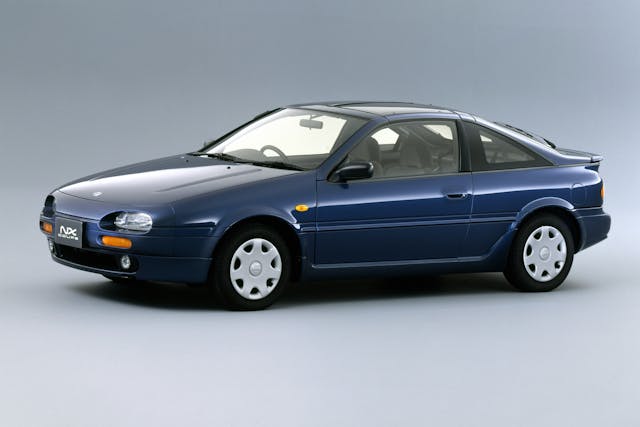
What is it? A curious-looking coupe that arrived in 1990 to replace the even weirder Nissan Pulsar EXA. It looks like it’s permanently squinting, but all models got a T-top roof arrangement, which probably helped it steal a few convertible buyers as well as traditional coupe types.
Why was it great? The NX’s greatness depends largely on where you live. American buyers got an NX 2000 with a healthy 140-hp SR20 engine, which made it a fun road car and turned it into a bit of a demon on the race track. The UK and most European countries were lumbered with a 1.6-liter making 101 hp at the most, and a chassis that wasn’t quite sharp enough to tempt people from their hot hatches.
Nissan Sentra SE-R

What is it? An unremarkable econobox turned into one of the best sport compacts of the 1990s. More of a coupe by definition than form factor—a bit like a two-door E30 BMW—the SE-R packed that same great 140-hp SR20 (as in the NX2000) and had independent suspension all around plus a limited-slip diff.
Why was it great? The SE-R is one of those perfect examples of what we miss about cars from the ‘90s. It’s not flashy, but it’s quietly handsome, a riot to drive, near-unburstable, and wakes up even more if you tinker with it a bit. They had a good run in lower-rung SCCA racing, can still hold their own at autocross today, and original ones always draw a crowd at Radwood.
Saturn SC

What is it? A sharply styled, plastic-bodied, pop-up–clad wedge based on Saturn’s S series models of the early ‘90s. It probably never got the power it deserved, offering up 123 hp at most from its 1.9-liter four, and it didn’t make up for lack of pep with a stirring soundtrack, either. But it did the job for thousands of happy commuters.
Why was it great? Saturn’s appeal was as much its sales model as its cars, but the S series in general and the SC in particular still drove well, and the plastic panels have helped survivors stand the test of time. Early first-generation cars are the sweetest eye candy, but while Saturn eventually ditched the pop-ups, late-’90s second-gen cars are notable too for having clamshell doors on the driver’s side only, years before the Hyundai Veloster revived the asymmetric door concept.
Toyota Paseo
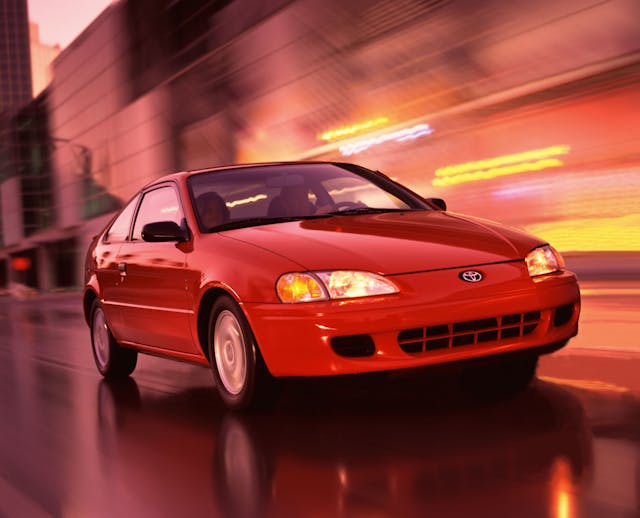
What is it? As was often the case with small coupes, the Paseo was based on something far more prosaic, the Toyota Tercel. Toyota sold the Paseo across two generations spanning almost the entire decade—early cars were a bit peppier, later ones arguably prettier.
Why was it great? “Great” is probably overselling the Paseo slightly. It never got a truly hot version and the struts/beam-axle suspension combo wasn’t as sophisticated as, say, the Honda CRX’s double wishbones. Several rivals looked sharper, too. But few small ’90s coupes could soak up the punishment of youthful owners quite as well; find a good one today and it’ll probably last forever.
Volkswagen Corrado

What is it? Volkswagen’s follow-up to two generations of Scirocco, and another car of the 1980s that really made its mark in the 1990s. It’s a little more grown-up than most on this list, and with the option of either a supercharged 1.8-liter four or 2.8-liter VR6 engine, you could say it was aimed at larger and more prestigious coupes. But it’s certainly compact, and indeed shorter than cars like the Paseo despite packing a much bigger punch.
Why was it great? The squat, squared-off, pugnacious styling is a Corrado highlight, even if you’d struggle to call it pretty, but the handling was the real star of the show thanks to its similarities with the Mk2 Golf GTI (rather than the disappointing Mk3 it overlapped with). Garrulous steering tells you exactly what the front wheels are doing, which is usually gripping very hard indeed.
***
Check out the Hagerty Media homepage so you don’t miss a single story, or better yet, bookmark it. To get our best stories delivered right to your inbox, subscribe to our newsletters.



1st gen CRX was my first new car. Ordered fall 1983 waited three long months for it and wore the printing off the C and D and R & T magazine articles about it in the mean time. Would love one now–might fit in the back of the F350. Would be a great towed vehicle for motorhoming. Weighed nothing. A wreck in one would not be good.
Sold CRX for Custom Cruiser with extra woodgrain and wires. Life changes. I’d like to have that car now too!!!
No love for the 240sx?
This is from “Across the Pond”, meaning the article was written from the English viewpoint. It’s possible that there was no love for the 240sx over there.
Hmmm…. at the outset you stated the cars were 2+2 cars, but included the CRX- a 2 seater. You failed to mention the Civic coupe! 125hp with the VTec.